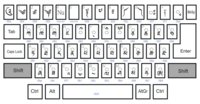Languages of Bhutan
| Languages of Bhutan | |
|---|---|
| Foreign | English, Hindi |
| Signed | Bhutanese Sign Language |
| Keyboard layout | |
There are two dozen languages of Bhutan, all members of the Tibeto-Burman language family except for Nepali, which is an Indo-Aryan language, and Bhutanese Sign Language.[1] Dzongkha, the national language, is the only native language of Bhutan with a literary tradition, though Lepcha and Nepali are literary languages in other countries.[2] Other non-Bhutanese minority languages are also spoken along Bhutan's borders and among the primarily Nepali-speaking Lhotshampa community in South and East Bhutan. Chöke (or Classical Tibetan) is the language of the traditional literature and learning of the Buddhist monastics.
Sino-Tibetan languages
Geographically, since
Dzongkha and other Tibetic languages
| Part of a series on the |
| Culture of Bhutan |
|---|
 |
| People |
| Languages |
|
Cuisine |
| Religion |
|
Art |
|
Literature |
| Music |
|
Sport |
The Central Bodish languages are a group of related Tibetic languages descended from Old Tibetan. Most Bhutanese varieties of Central Bodish languages are of the Southern subgroup. At least six of the nineteen languages and dialects of Bhutan are Central Bodish languages.
Dzongkha is a Central Bodish language
The Lakha (8,000 speakers) and Brokkat languages (300 speakers) in Central Bhutan, as well as the Brokpa language (5,000 speakers) in far Eastern Bhutan, are also grouped by Van Driem (1993) into Central Bodish. These languages are remnants of what were originally pastoral yakherd communities.[2]
The Laya dialect, closely related to Dzongkha, is spoken near the northwestern border with Tibet by some 1,100 Layaps. Layaps are an indigenous nomadic and semi-nomadic people who traditionally herd yaks and dzos.[5][6][7] Dzongkha speakers enjoy a limited mutual intelligibility, mostly in basic vocabulary and grammar.[8]
Khams Tibetan is spoken by about 1,000 people in two enclaves in Eastern Bhutan, also the descendants of pastoral yakherding communities.[2] Although it also is a by all accounts a Tibetic language, its exact subgrouping is uncertain.
East Bodish languages
Eight of the languages of Bhutan are East Bodish languages, not members of the closely related Tibetic group but still likely descended from a close kin.[9]
The Bumthang language, or Bumthangkha, is the dominant language in Central Bhutan. It has approximately 30,000 speakers. The Kheng and Kurtöp languages are closely related to Bumthang. They have 40,000 and 10,000 speakers, respectively.
The
The
Other Tibeto-Burman languages
Other Tibeto-Burman languages are spoken in Bhutan. These languages are more distantly related to the Bodish languages, and are not necessarily members of any common subgroup.
The Tshangla language, a subfamily of its own of the Bodish languages, has approximately 138,000 speakers. It is the mother tongue of the Tshangla people, generally known by its exonym Sharchops. It is the dominant language in Eastern Bhutan and was formerly spoken as a lingua franca in the region.[2]
The Gongduk language is an endangered language that has approximately 1,000 speakers in isolated villages along the Kuri Chhu river in Eastern Bhutan. It appears to be the sole representative of a unique branch of the Tibeto-Burman language family,[12] and retains the complex verbal agreement system of Proto-Tibeto-Burman.[13] Van Driem (1993) describes its speakers as a remnant of the ancient population of Central Bhutan before the southward expansion of the East Bodish tribes.[2]
The Lhokpu language has approximately 2,500 speakers. It is one of the autochthonous languages of Bhutan and is yet unclassified within Tibeto-Burmese. Van Driem (1993) describes it as the remnant of "the primordial population of Western Bhutan," and comments that Lhokpu or a close relative appears to have been the substrate language for Dzongkha, explaining the various ways in which Dzongkha diverged from Tibetan.[2] It is spoken by the Lhop people.
Border languages
The Lepcha language has approximately 2,000 ethnic Lepcha people in Bhutan.[2] It has its own highly stylized Lepcha script.
The
The
Indo-European languages
Indic languages
The
European languages
Although the
References
- ISBN 90-5789-002-X.
- ^ SOAS. Archived from the original(PDF) on 2018-09-11. Retrieved 2011-01-18.
- ^ Dzongkha at Ethnologue (15th ed., 2005)

- )
- ^ Wangdi, Kencho (2003-11-04). "Laya: Not Quite a Hidden Land". Kuensel. Archived from the original on 2003-12-07. Retrieved 2011-09-26.
- ^ Layakha at Ethnologue (16th ed., 2009)

- ISBN 90-5789-002-X. Retrieved 2011-09-27.
- ^ "Tribe – Layap". BBC Online. 2006-05-01. Retrieved 2011-09-26.
- ^ van Driem, page 18
- ^ Tshering, Karma (2001). Languages of the Himalayas: An Ethnolinguistic Handbook of the Greater Himalayan Region. Brill.
- ISBN 0-7007-1129-5.
- ^ Himalayan Languages Project. "Gongduk". Himalayan Languages Project. Archived from the original on 2011-07-26. Retrieved 2009-11-06.
- ^ "Gongduk: A language of Bhutan". Ethnologue Online. Dallas: SIL International. Retrieved 2009-11-06.
- ^ ISBN 978-90-8964-127-4.
- ^ Lewis, M. Paul, ed. (2009). Ethnologue: Languages of the World (16th ed.). Dallas, Texas: SIL International.
- ^ ISBN 0-7425-4972-0.
- .
- ^ Hays, Jeffrey. "Languages in Bhutan". Facts and Details. Retrieved 2024-01-18.
External links
- Dzongkha Development Commission - Official language body of Bhutan



![Part of the Sino-Tibetan language family, largely following Thurgood and La Polla (2003).[11] Here, the Monpa and Lepcha languages are shown as sister languages to Old Tibetan (all are grouped into the Bodic languages).](http://upload.wikimedia.org/wikipedia/commons/thumb/5/5f/SinoTibetanTree.svg/1000px-SinoTibetanTree.svg.png)
